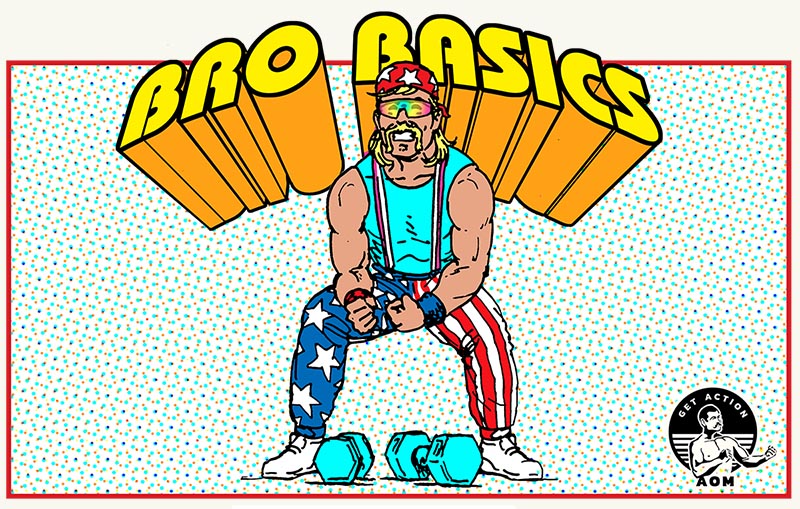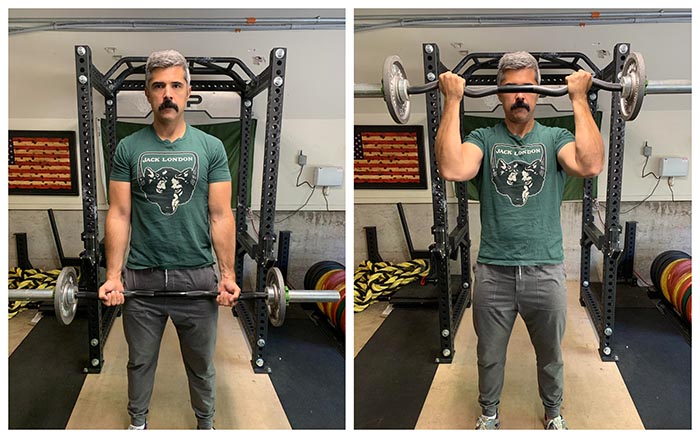
Here at AoM, we’re big proponents of doing strength exercises that give you the most bang for your buck. That means we advocate for compound barbell lifts that allow you to work the most muscles possible, lift the most amount of weight, and get all-around strong. We’re talking deadlifts, squats, shoulder presses, bench presses, and various Olympic lifts.
When you follow this philosophy, it can be easy to become overly dismissive of the kind of exercises that one associates with “bros” working out in front of the mirror at globo gyms — exercises that are focused on honing the aesthetics of one’s physique and target single, specific muscles like curls, tricep extensions, and lat pulldowns.
But while these lifts are often associated with vanity, they do serve functional purposes and can be a part of a balanced strength training program. Not to mention, they can also be a lot of fun; getting a nice pump from doing a set of bicep curls is an undeniably great feeling, and you don’t need to apologize for that.
While these exercises shouldn’t be criticized for being pointless, they should be criticized for often being done poorly. Just because they’re not as “serious” as stuff like the deadlift and squat, doesn’t mean you shouldn’t learn how to perform them with good technique and form to maximize their benefits.
So today, we begin a series on the whys and hows of these accessory exercises. We’re calling it “Bro Basics.”
We begin with the Platonic Form of the Bro Basic: the bicep curl. For insights on how best to perform this exercise, I talked with my strength coach and head of Barbell Logic Online Coaching, Matt Reynolds.
The Anatomy of the Bicep(s) Muscle
Before we dig into how to do different variations of the bicep curl, a quick anatomy lesson.
While we commonly refer to the muscle on the front part of the upper arm as a “bicep,” the muscle is technically called “biceps,” as it’s made of two (bi) muscle heads — the long head and the short head — that work together as one muscle.
The long head originates from up by your shoulder in a cavity in your scapula called the glenoid. The short head originates at a projection in the scapula called the coracoid.
The long and short head join together in the middle and connect to the bone via tendons just beneath the elbow joint on a place called the radial tuberosity.
Something to point out about the biceps is that it’s a lot longer than you think it is. It crosses both the shoulder and elbow joints. To ensure we work the entirety of the biceps as much as we can, we want to perform a curl that uses the muscle’s full range of motion. More on that a bit. But store that info away in your working memory for the next 30 seconds.
Why Do Bicep Curls?
Strengthens a functional movement you do multiple times a day. The bicep muscle is what allows you to bend your arm at your elbow and rotate your forearm. Think about all the movements you do that require that motion — pulling the lawnmower starter, hammering, unscrewing a stuck jar lid, picking up heavy stuff. Curls strengthen your biceps, which makes these movements easier.
Rehabs tendonitis. Bicep tendonitis is a common ailment for people who are serious about weightlifting. I’ve battled it a few times during my five-year lifting career. Matt likes to program high rep bicep curls whenever I’m struggling with tendonitis as part of my rehab. The idea is that the high reps pump in hefty amounts of fresh blood to the tendons (which carry nutrients to the injured area). This is super important for tendons because there is very little blood flow to them anyway, so every little bit helps.
Strengthens the bicep, which indirectly contributes to the main barbell lifts. While the biceps aren’t directly used in lifts like the shoulder press or the bench press, they do stabilize the elbow and shoulder joint while you perform these lifts. Strengthening your biceps can thus indirectly improve your bench and shoulder press.
They’re fun. I enjoy doing bicep curls, so I do them. Never downplay the fun factor when it comes to exercise.
They make your arms look good. People see biceps as a sign of masculinity and virility. Having a jacked arm looks dope. There’s nothing wrong with wanting that. Curls for the girls, brother!
Busting a Myth: Curls Can’t Be Used to Sculpt Your Bicep Into a “Peak”
A lot of guys hit the bicep curls hard in the hopes of sculpting their bicep to look like a round softball beneath their skin. Unfortunately, bicep curls won’t help you achieve more “peak” or height . . . unless your physiology allows for it.
“How round a bicep muscle looks when you flex is completely due to the insertion points of the bicep tendons into the elbow joint,” Matt says. “If you have a higher insertion point, your bicep will have that more round look; with a lower insertion point, the bicep will look longer and not as peaky. Bicep curls can’t change your insertion point, but they can make your biceps bigger and stronger, so go for that.”
How to Do Bicep Curls
All bicep curls involve holding weight in your hands, and lifting that weight towards your face. But there are a variety of types of curls, depending on the kind of weight/equipment you use:
The King of the Bicep Curls: The Barbell Curl
 Using a barbell for a bicep curl rules supreme because it puts your hands in a completely supinated (underhand) position, which allows for a stronger muscle contraction. Here’s how to do this exercise correctly:
Using a barbell for a bicep curl rules supreme because it puts your hands in a completely supinated (underhand) position, which allows for a stronger muscle contraction. Here’s how to do this exercise correctly:
- Stand tall, holding the barbell with your hands just outside of your hips and using an underhand/supinated grip.
- Without swaying your body (this is often called “body English” or “cheating a curl”), raise your hands towards your face so that your elbows begin to bend. You should feel the bicep muscles start to contract.
- Curl the bar so that it comes up to your eye level. You should feel your shoulders flex a bit, and your elbows move up. This is important! Most people stop the curl when the bar gets to their shoulders. But this doesn’t stimulate the biceps’ full range of motion. Remember, the bicep muscle crosses the shoulder joint as well. When you stop the bar at shoulder level, you’re only working the lower part of the bicep. Bringing the bar to eye level will ensure you also work the top part of the bicep near your shoulder.
- When you’re at the top of the lift, don’t let the bar get too close to your body. When the bar gets close to your body, you lose muscle contraction. Keeping the bar away from your body allows you to maintain constant contraction. There shouldn’t be any point in the barbell curl where it feels easy.
- Start to lower the bar slowly, keeping your biceps tensed and engaged. Lower to the starting position.
Some people experience pain in the wrists or elbows while doing a barbell curl. If this is you, simply take a wider grip until you no longer feel any pain in these areas. If you still feel pain in your wrists and elbows after taking a wider grip, you’ll need to use an alternative bicep curl exercise, like those below.
Dumbbell Bicep Curls

The classic way to do the bicep curl. It won’t give you as strong of a muscle contraction as the barbell curl, but it can feel more comfortable on the wrists and elbows.
- Hold the dumbbells at your sides with your palms facing forwards.
- Without leaning back or swinging the dumbbells to get momentum, bend at the elbow to curl the weights up to eye level. (Remember to work that top part of the bicep!) Keep your elbows fixed to the sides of your torso throughout the curl.
- Lower the weight slowly back to the start position.
EZ Bar Bicep Curls

Invented by weightlifter Lewis Dymeck back in 1950, the EZ curl bar has a slightly bent shape that resembles a “W.”
The bent profile of the bar allows you to take a less supinated/more neutral grip while performing the curl, which reduces the stress on the wrists and the elbows. However, by taking a less supinated grip, you’re not going to get as strong of a contraction in the bicep muscles as you would with a standard barbell curl.
Perform the EZ bar curl just as you would a standard barbell curl.
Hammer Bicep Curls

The hammer curl is just like a dumbbell curl, but instead of a supinated or underhand grip, you maintain a neutral grip throughout the entire exercise. A neutral grip is a grip you’d take while hammering a nail, hence the name, hammer curls.
The hammer curl doesn’t actually work the bicep muscle all that much. It primarily targets the brachioradialis and brachialis (forearm flexors which lie underneath the bicep above and beneath the elbow). Hammer curls will give you some contraction in the lower part of your bicep, as well as increase the size of your forearms.
Matt likes to use hammer curls primarily for rehabbing and injury prevention, particularly for individuals who struggle with tendonitis near the elbow.
“Since you don’t get much of a bicep contraction with hammer curls, it doesn’t exacerbate existing tendonitis. However, the curl movement will pump blood to the area, giving your tendonitis needed nutrients to recover. I like to keep the weights low and the reps high with hammer curls. 12-15 reps are the ideal range for hammer curls,” he told me.
Other Curl Variations
There are other bicep curl variations out there, but for the regular Joe, they’re not very useful. “If you’re a bodybuilder, you might consider doing concentration curls,” Matt says, They’re great for adding time under tension on the bicep, which can help with hypertrophy [where the muscle gets bigger], but for the most bang for your buck, stick with the barbell curl. Nothing works the bicep better.”
Programming Bicep Curls
The bicep curl should be used as an accessory lift to the main barbell lifts. Matt likes to have clients do bicep curls on the days they do upper body workouts. For example, he usually programs bicep curls for me as a part of an upper body circuit on the days I shoulder press and bench press.
For general strength, Matt recommends barbell curls for 3 sets of 5 at a decently heavy weight. You can add 5 pounds a week to your weight.
After you do your strength sets, pick another curl alternative and do it at a lighter weight for higher reps. My go-to is the hammer curl. I’ll use 25 lb dumbbells and do 3 sets of 15. Just going for a good pump and prehabbing tendonitis issues.
Tags: Bro Basics, Exercises

